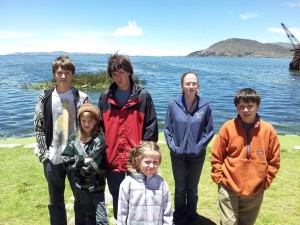
Two weeks in Puno, Peru and it seems like we live here. We are camped at a very nice grifo station on the south end of town (Salsado) on the shore of Lake Titicaca, which is actually marshy and not the kind of shore you can stroll along. There are sheep at the grifo station and we are tucked into a back corner, safe and secure. A family lives here and they have been, as everyone we have met so far, most kind and helpful. They have a daughter who is learning English and she works at a hotel here in Puno. She helped us get much needed laundry done and arranged a tour for us of Uros, the Floating Islands.
Laundry cost almost $100 USD. We had a lot of laundry but still that seemed like a lot. Laundry here is dropped off dirty and they charge by the kilo and return it pressed and folded. We were having some trouble washing laundry well by hand. I never learned really how to wash laundry well by hand, not whole loads of laundry. A quick google search and some chatting with people who always wash laundry by hand and Team DeCorso has hand washing laundry down! Here is how we do it:
Water and detergent dissolved in a 5 gallon bucket. Add clothes (not too many). Let them soak for 30 minutes. We bought a new toilet plunger and use it to agitate the laundry for 15 minutes. Then we remove the laundry and let it drain for 15 minutes. Next we use three buckets of rinse water and some plunger action to rinse and hang it out to dry.
We have had several exciting things happen since we have been in Puno:
- School stuff
- Cell phone stuff
- Hospital stuff
- Roof rack creation
- Hats!
School Stuff: We were getting worried about the accuracy of our shipping quote back to the states. The time seemed to fluctuate between five days and 21 days and 4 kids need to be back in Alaska for standardized testing. If the shipping is 21 days and there was a storm or a political problem, we might not make it back in time. If it was the original 5 days, all would be fine. We decided to unenroll 4 kids from school. What this did was open up a world of possibilities and some flexibility in getting back. We are now free to ship out of a better location a week later if we so desire. We have not made any changes at this time and are still planning on shipping out of Lima. But we COULD change our minds now and that adds some excitement!
Cell Phone Stuff: We bought a smartphone in Fairbanks and had it shipped here (THANK YOU MARY!!) and, even though that took less than 2 days, the phone is still in customs hold. And we are in Puno for at least another few days. The customs process makes no sense; it costs no fees and everyone is earnest and sincere – and it still makes no sense. Our used cell phone is being held in Lima until we fill out a form (which the Ministry did for us), mail it to Lima (which the Ministry did for us and paid for express mail for us while walking us 7 blocks to the mailing place), Lima generates a letter and sends it to us and we send it back to DHL in Lima. On Monday, we are going to try to have the letter sent directly to DHL. Probably won’t work. No one seems to know why we need to do this. Once the letter gets to DHL in Lima, they will ship the phone and we will leave Puno.
Hospital Stuff: Max got bit by a dog. A stray dog was sleeping under the van and Max opened the door and the dog bit him on the leg, a bloody bite that took out chunks of skin. The bite was not very bad, it looked like it might have taken a few stitches maybe but there was the possibility of rabies. Mark & Ryan took him to the hospital (imagine flies and a lot of people) and returned with a Puno Official who came to find the dog to see if it had a rabies shot – which was practically impossible. There are stray dogs everywhere here. Many live at the trash piles and they are not nice like Ecuadorean dogs; they are snarly and mean and everyone is afraid of them. Ryan and I feed the nicer stray dogs because sometimes we just feel so bad for them. It seemed like Max was heading back to the Hospital for a full compliment of rabies vaccinations. He didn’t know what that meant and he was in his usually good spirits telling me that he wouldn’t mind a shot, making me nearly cry. But! (and this is a miracle) the dog had a rabies tag! Everyone was shocked and surprised, no one expected the dog to have a rabies shot! Max got a prescription for antibiotics and his leg healed up well. Total cost for dog bite: $8 USD.
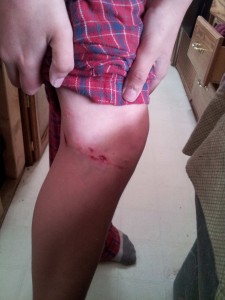
A Custom Roof Rack has been a dream of Mark’s. And now we actually need one. We need to carry 25 gallons of deisel as we travel the southwest circuit of Bolivia and then we need one to put things on the roof when we head back because we have decided that we are selling the camper in South America. So for a few days, the van has to hold everything. Peru is a great place to get this done as there are guys with welding stuff and recycled stuff and metal and such everywhere.
Hats: the hat project has become the #1 activity in Puno. Ryan has a list of requests and items and we venture out every day to buy some hats. It is more challenging than you might think as some of the people most desperate for money have kind of bad hats. We buy some bad hats but mostly we buy great hats for about $4 usd each. I know Ryan has a lengthy blog post he is writing about this but I wanted to give a short update. Ryan has been kind of busy this week as the colleges he has applied to all come out with their official scholarship offers and he has had a lot of forms and such to fill out. The hat project is going very well.
Stuck in Puno
Frommer’s says Puno is not worth spending an entire day in. Frommer’s also says that Puno is “bleak, unimpressive and often brutally cold and not one of Peru’s most interesting or attractive cities” and “a mostly unlovely city”. Team DeCorso however, LOVES Puno. Brutally cold? Are you kidding? We have to wear a fleece jacket at night. Bleak? Puno is full of activity, every single night and lovely parks, playgrounds, music, parades, singing, dancing and wood-fired pizza all on the shore of Lake Titicaca. We could not have picked a better place to be stuck waiting for the phone. The cost of living is quite cheap here, allowing us to live like the fabled 1%. A large wood-fired pizza in candlelit restaurant is $8 USD. On Saturdays, the market is the biggest we have encountered in South America. Frommer’s says the market is “seedy”, “unattractive” and “a realistic look at the underbelly of the Peruvian economy”. WTF Frommer’s? We have found the market to be amazing. Everything is for sale here from dishware to tradtional Cholita dresses, llama fetuses, witchcraft, perfume, knock off North Face jackets, yarn, fabric, used Happy meal toys… We spent two wonderful Saturdays dodging the many marching bands (why so many marching bands we cannot know) and meandering the market. For 1 sole (forty cents in the USA) I can buy a ring, a small skein of yarn, a jar of buttons, a saltena (deep fried bread stuffed with potatoes, olives, egg and chicken), 10 pairs of shoe laces, two hair scrunchies, a tin cup, a small bag of good luck potion, a 3D religious poster, a salsa CD with 168 songs on it or five spoons. I am often shocked at the low prices and cannot bargain down at all. I bought Sylvia a waldorf style knitted doll made from alpaca and stuffed with wool from the Women’s Cooperative and it was $2.80 USD.
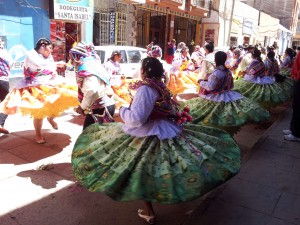
People here are so much more efficient than we are used to. We always pride ourselves on recycling and reusing items but it does not hold a candle to Peru. So many things I would have (and have) thrown away are rebuilt, reused, fixed and sold. Many things I think of as disposable are not that way here. Ryan has a pair of LLBean hiking boots we bought him last summer. He is hard on shoes and they have fallen apart. A hole, a rip, a torn off lace holder, no tread. He took them to the mercado and for 7 soles ($4.80), they sewed the holes, replaced the tread, fixed the lace holder and put new insteps into each shoe. They are better than new.
About half of the people here wear traditional dress and that traditional dress is really amazing because it is complicated and heavy. Women here traditionally wear layers (and layers and layers and layers). Several skirts under a felt skirt, several shirts under a blouse, all topped with a fabulous apron smock, then shawls and blankets, socks, stockings and leg warmers, wrist warmers, fingerless gloves and mittens, knit hats under tiny bowler hats, scarves and heavy hair jewelry – beads and pompoms woven into braids. Often carrying a similarly dressed small child wrapped in a blanket like a sling. Makes me nearly pass out just watching as even standing up at 12,080 feet can make you dizzy – I cannot imagine wearing so many heavy things and then carting a baby and potatoes around! The market has shops that sell each specific layer. I loved the apron smock thing. I bought one for myself, one for Sylvia and one for Shana.
We spent a day on Uros, the Floating Islands where we ate grass (the banana of the Uros), bought a little reed boat for Sylvia’s dolls, and had an enjoyable sunny day on Lake Titicaca. The islands are 2m thick. They harvest 1m chunks of reed roots now in the rainy season to form the floating base and then cover them with 1m of reeds. The islands are spongy to walk on. They have a school, a Seventh Day Adventist Church, several restaurants and homes, although made of reeds, have solar panels and internet.
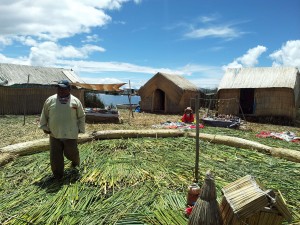
Most of the time, we wander around town. We have made friends (the owners of the vegan restaurant, the Uruguayan man who works at the coffee shop, the woman at the IPeru office who has been helping us with the phone…). We eat out more here, food is almost as cheap to eat out as it is to cook. We had Chifa (Peruvian Chinese, very common) which is rice stir-fried with cut up hot dogs three ways: 1. with french fries 2. with pasta 3. with pasta and french fries (the Triple). One of our favorite places is the Salchipaparia (salchipapas are french fries with cut up hot dogs) where you can get a plate or a cone of salchipapas. For some reason in Peru, they filet the hotdogs to look like squids. It’s kind of unappealing. More or less, the food here is starchy and bland. Rice, pasta, and french fries are the basis of all meals. Meat, except chicken, is unknown – llama, alpaca, cuy, pork, beef?
We play a game here called the Peruvian Lucky Food game – who gets the hair? We sometimes have multiple winners at any meal out. We have never once had food in Peru where no one got a hair, except at the excellent vegan restaurant.
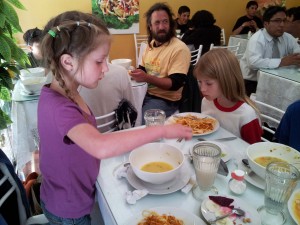
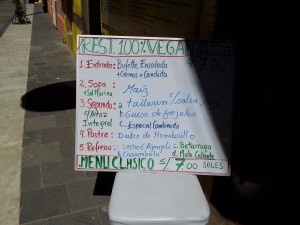
Otherwise it has been very relaxing and fun. We found clay for sale here and Sylvia has been playing with clay for the last two weeks. It doesn’t harden (its paraffin based) but it does eventually turn all one color – grey. The kids rediscovered Boggle and we have been playing every day. They keep on their music lessons so there is always music being played, the piano keyboard but also the mandolin, pan flute, ocarina, bag pipe chanter, charango, charangón, ronroco, hualaycho, zampoña, quena, bombo, huancara, reco reco, chiapya box, pinquillo, tarka, toyos, pututu and Andean saxophone – another reason why we need the roof rack.
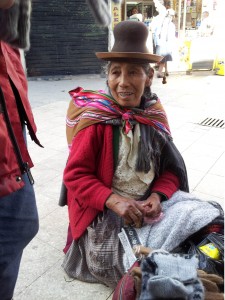
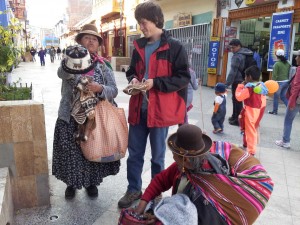
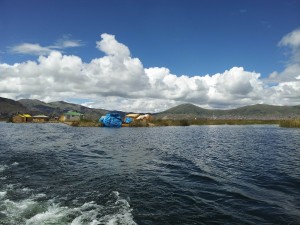
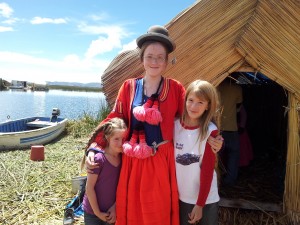
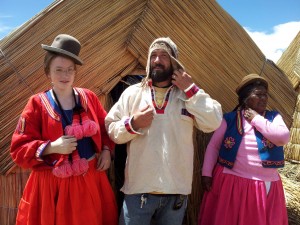
Hey DeCorso’s Kids, I looked about post and pic kids so great looks and braves travels longest, I am worrying you about that and Much Missing you Lots on Holidlays! I am glad you have wonderful’s trips and fun looks things. Please care yourself and your eyes keeps on familys.
Miss&Love,
Uncle Danny
This post is fabulous! fabulous! Thanks Michelle. I look forward to these. The food descriptions are hilarious, we love the photos, and I can’t wait to see the Andean saxophone. I don’t know how you guys manage all this, and do the posts as well.
Love you all,
Grandpa Ted